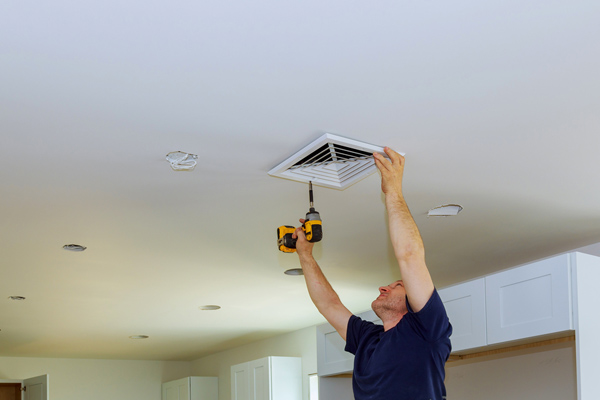Cooling and Heating Capacity:
When shopping for a mini-split ceiling cassette unit, its heating and cooling capacities should be among your top priorities. This shows the system’s capacity to heat or cool a certain area and is measured in British Thermal Units (BTUs). Select a unit with the right BTU rating based on the square footage of the area you want to cool. It may be difficult for undersized units to achieve the target temperature, and excessive energy consumption and inefficient operation are the results of oversized units.
Energy Efficiency:
You can protect the environment and save money on energy costs by installing a mini-split ceiling cassette unit. When shopping for a heating and cooling system, make sure you choose one with a high HSPF and a high Seasonal Energy Efficiency Ratio (SEER). You may rest assured that your investment will be well-protected because Energy Star certified units often fulfill strict efficiency standards.
Noise Levels:
If you’re trying to get some rest in a bedroom or a peaceful office, the mini-split system’s background noise may be unbearable. Take the unit’s decibel (dB) rating into account; lower ratings indicate quieter operation. You can enjoy a calm environment even when the unit is running thanks to features like “quiet mode” or sophisticated fan blade designs that reduce noise.
Installation and Space Constraints:
Although mini-split ceiling cassette units are renowned for their installation flexibility, it is essential to take note of the room’s dimensions and layout. These units are designed to be flat with the ceiling, which allows for maximum space savings and an unobtrusive look. Before installing the unit, check that there is adequate space and think about any architectural limitations, like beams or other structural components, that can hinder the process.
Airflow Direction and Distribution:
Keeping the room at a constant temperature requires precise control over the flow of air and how it disperses. In order to personalize the airflow pattern, search for units that have adjustable louvers or several air vents. In order to make sure that the conditioned air reaches every part of the room, some more advanced versions have 3D airflow technology.
Air Quality Features:
A lot of modern mini-split ceiling cassette units have innovative air filtering technologies that make the air inside much better. Think about buying a unit that has ionizers, UV-C lights, or multi-stage filtration to get rid of microbes, allergies, and airborne particles. Anyone suffering from asthma or allergies should pay special attention to this.
Remote Control and Smart Features:
Your level of satisfaction with your mini-split system is heavily influenced by how convenient it is. Make sure the units you’re considering have easy-to-use remote controls so you can change the settings from a distance. Smart features are available on some models as well, allowing for easy control and monitoring through smartphone apps or home automation systems.
Maintenance Requirements:
Your mini-split ceiling cassette unit will last longer and work better if you service it regularly. Find models that have easily accessible filters and parts that are simple to clean. You won’t have to clean it as often because certain models include built-in cleaning mechanisms that keep dust and mold away.
Brand Reputation and Warranty:
When you buy a mini-split system from a trusted company, you can rest easy knowing that it will last and work as claimed. You should also think about the manufacturer’s warranty. A longer and more extensive warranty shows that the brand is confident in their product and provides protection for any problems that might develop over time.
Cost and Budget Considerations:
Although it is critical to purchase a high-quality mini-split ceiling cassette unit, it is of equal importance for you to stick to your budget. Find a unit that satisfies your needs without breaking the bank by comparing features, costs, and energy efficiency ratings. Consider the possible reduction in energy costs over time when calculating the total cost of ownership.
Zoning Capabilities:
To maximize energy efficiency and provide individualized comfort, zoning enables you to independently regulate various sections or rooms. It is possible to link numerous indoor mini-split cassette units to a single outdoor condenser in certain models that offer multi-zone arrangements. Having this feature is great for buildings that have diverse heating and cooling requirements in different parts of the building.
Inverter Technology:
Mini-splits that use inverter technology are better at regulating temperature and using less energy. While conventional systems run at a constant speed, inverter technology allows the compressor speed to be adjusted according to the target temperature. This reduces energy usage by minimizing repeated starts and stops and speeds up cooling or heating cycles.
Compatibility with Renewable Energy Sources:
A mini-split ceiling cassette unit that works with solar panels and other renewable energy sources is a great option for eco-conscious homeowners. You can lessen your impact on the environment and your dependence on traditional power sources by using one of these models in conjunction with a solar power system.
Humidity Control:
Keeping the indoor climate comfortable requires efficient humidity regulation. To lessen the likelihood of mold development, boost IAQ, and increase general comfort, search for mini-split units with dehumidification capabilities. In humid locations, models that have humidity settings that may be adjusted or that have a specialized dehumidification mode are especially helpful.
Compatibility with Smart Thermostats:
Make sure the mini-split ceiling cassette unit is compatible with your smart thermostat if you already have one installed. Through this integration, you may optimize your energy usage according to your daily patterns with centralized control and scheduling. With a smart thermostat, you can save energy and enjoy the convenience of remote monitoring and adjustments.


